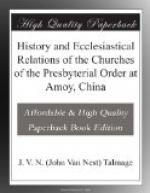foundation of Presbyterial order. A full discussion
of this subject will come up most naturally when we
discuss the
evils of the course now required
of us. I will now allude to only one fact.
The Board of Foreign Missions was formed on this principle.
If the Classes at Arcot and Amoy are to be considered
integral parts of the Church in this country,
related to General Synod like the Classes in this country,
then the Missionaries at those stations properly should
come under the Board of Domestic Missions. Suppose,
according to the new plan, the Missionaries form themselves
into the kind of Classis now required of them; what
will be the relation of the Classis of Amoy to the
Board of Foreign Missions? Is the Classis, in
evangelizing the heathen around, to operate through
the Board, or the Board through the Classis? The
Classis at Amoy decide on a certain course of ecclesiastical
procedure, or evangelistic labor, and the Board decides
on another course; how is such a matter to be settled?
Will it be said, there is no danger of such difficulty?
The Classis and Board will both be composed of men
with infirmities. Ask the Board whether there
have not already been incipient difficulties, in the
supposed clashing of the powers of the Board and the
powers of the Classis of Arcot. But the Classis
of Arcot as yet is little more than an
American
Missionary Classis. What will be the difficulties
when it becomes an
Indian Classis? But
we are told, “keep the Mission and Classis distinct.”
Is the Mission, then, to attend to all the evangelistic
work, and the Classis to do nothing? Or are there
to be two distinct evangelistic policies carried on
at Amoy, the one by the Mission, and the other by
the Classis? Or is the Classis first to come
over to the Synod, and so get to the Board in order
to carry on the work around? Instead of this
new plan being the settled policy of our Church, we
believe it to be a solecism. When a Church is
established among the heathen after our order, then
is the true policy of our Church carried out.
Let the present relations of the Missionaries to the
Board and to their several Classes remain, and there
will be no occasion for the clashing of the powers
of the Board with those of any ecclesiastical body.
So much for the advantages. They are really
disadvantages, leading to serious evils, which
of themselves should be sufficient to deter the Church
from inaugurating the policy proposed, or, if it be
already inaugurated, to lead her to retrace her steps,
and adopt a better and a consistent policy.
Now let us consider the real or supposed Evils
(in addition to the above) of carrying out the decision
of Synod.
1. It will not be for the credit of our Church.
She now has a name, with other Churches, for putting
forth efforts to evangelize the world. Shall
she mar this good name and acquire one for sectarianism,
by putting forth efforts to extend herself,
not her doctrines and order;—they are not
sectarian, and her Missionaries esteem them as highly
as do their brethren at home—but herself,
even at the cost of dividing churches which the grace
of God has made one?




